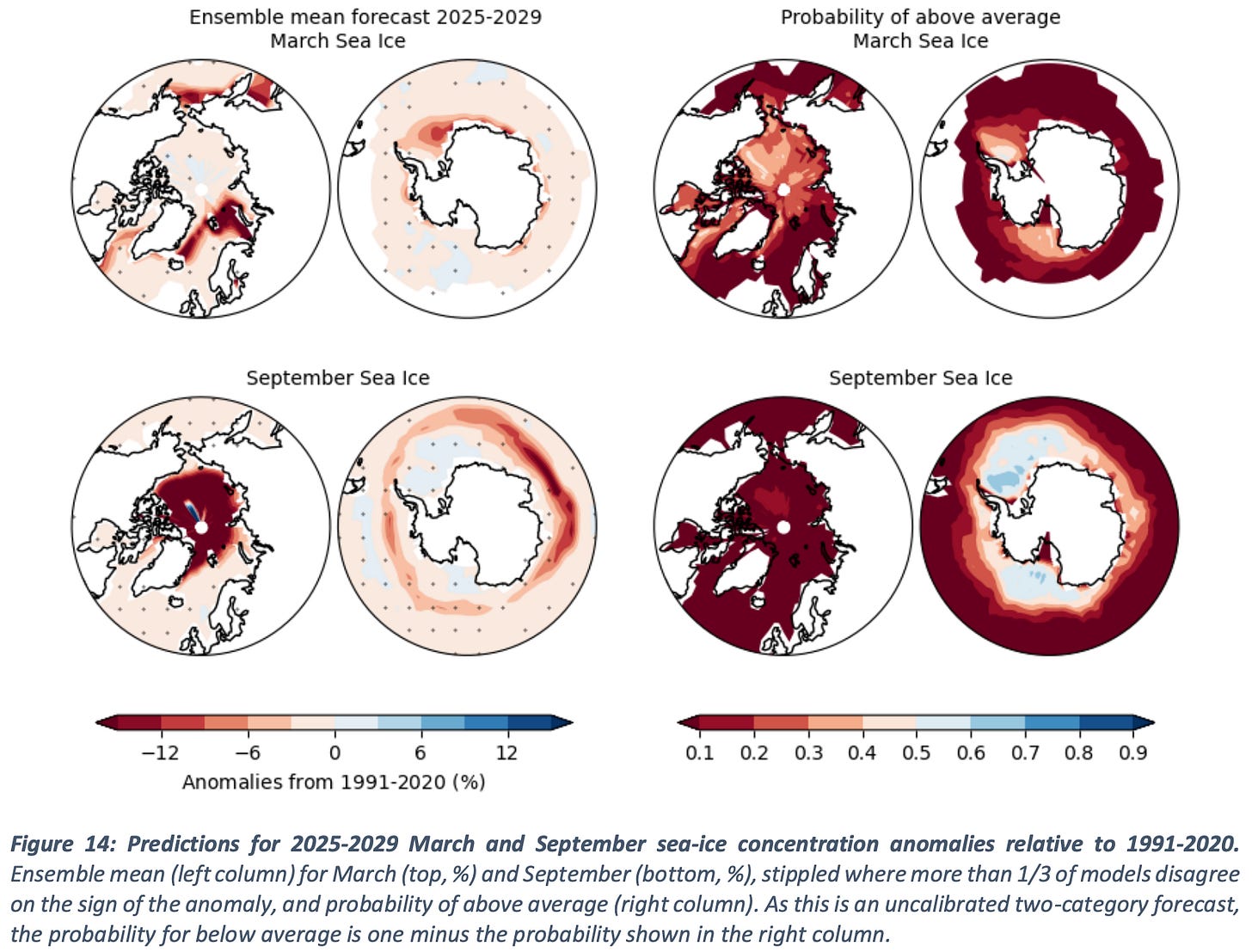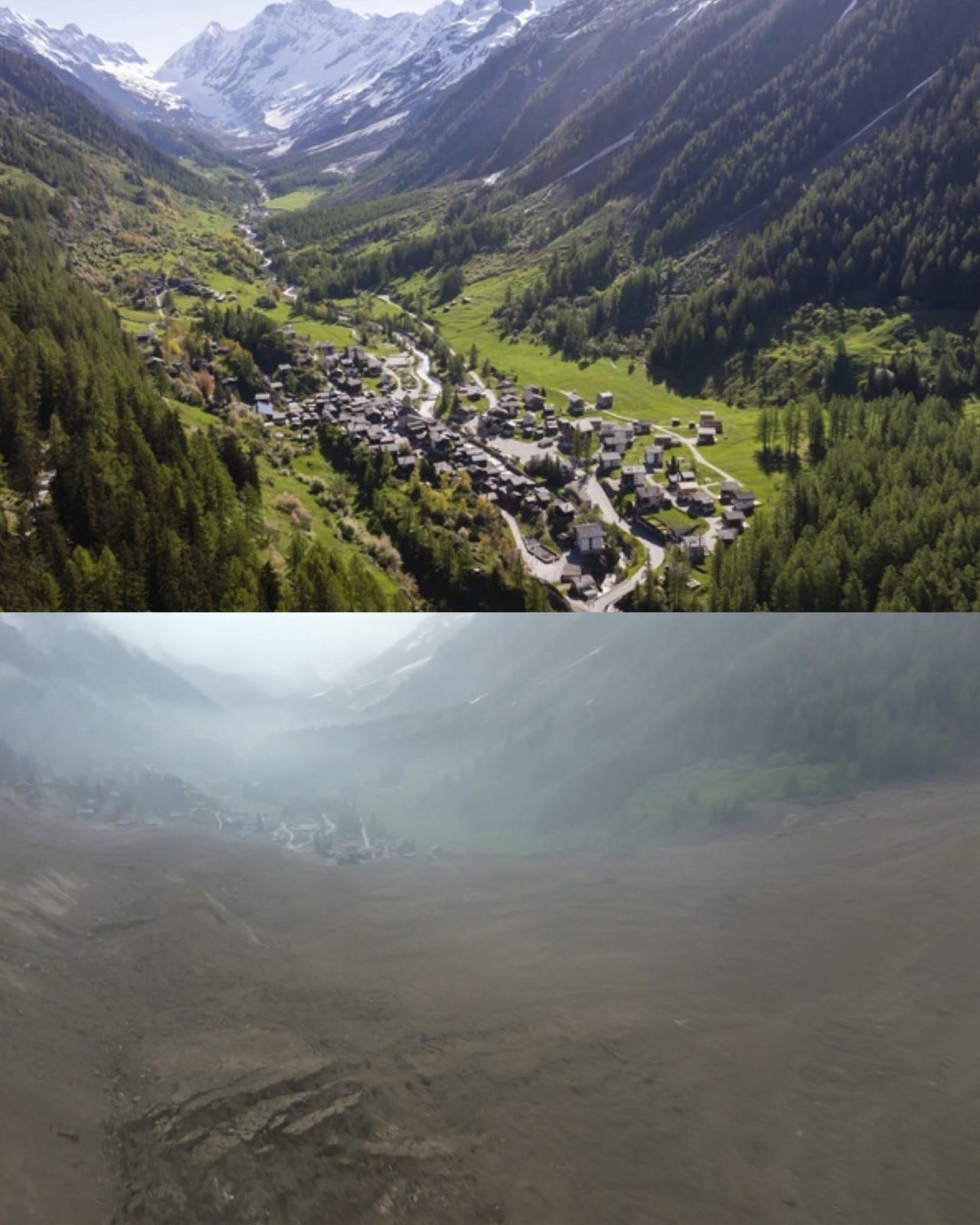Last Week in Collapse: May 25-31, 2025
Prophecies of heat, microplastics across the food chain, glaciers falling apart, cholera, hybrid war, and a total moral collapse.
Last Week in Collapse: May 25-31, 2025
This is Last Week in Collapse, a weekly newsletter compiling some of the most important, timely, useful, soul-crushing, ironic, amazing, or otherwise must-see/can’t-look-away moments in Collapse.
This is the 179th weekly newsletter. You can find the May 18-24, 2025 edition here if you missed it last week. Thank you for subscribing to the Substack.
——————————
An updated climate forecast by the WMO examined the next four and a half years, and concluded with strong probability (86%) that at least one of the next years, 2025-2029, will hit 1.5 °C. The scientists give a 1% chance of hitting 2 °C in one of those years—if a strong El Niño converges with a positive arctic oscillation. Some experts believe we are on track for 2.7 °C warming by 2100.
“Last year, 2024, was the warmest year on record, with the globally averaged near-surface temperature estimated at 1.55 °C ± 0.13 °C above the 1850–1900 baseline….The chance of at least one year exceeding the warmest year on record, 2024, in the next five years is 80%....The North Atlantic subpolar gyre, the main centre of action of the AMV, has had positive near-surface temperature anomalies in the last five years….For the November to March average over the years 2025/26-2029/30, the predictions show that warm anomalies are likely almost everywhere, with land temperatures showing larger anomalies than those over the ocean….” -excerpts from the 27-page report
A Swiss village was totally buried by the Collapse of the Birch Glacier. The settlement had been evacuated 10 days earlier, thanks to warnings by geologists. Watch a 47-second video of the full Collapse, from a distance, here.
Saudi Arabia saw its hottest May day of all time, at 52.2 °C (126 °F). Qatar as well. Windstorms in Pakistan slew 14 and injured 100+ others. Meanwhile, Bengaluru (metro pop: 14M+) ended its wettest May on record, with about 308mm of rain. This year, Indian monsoon rains came 16 days early. Flooding in Nigeria killed at least 115.
A heat wave in Siberia brought temperatures exceeding 30 °C, in some places over 34 °C (93 °F). Temperatures on the island of Crete (pop: 625,000) stayed above 35 °C almost all night on Sunday. Brutal temperatures in California. In Khartoum, scorching 45 °C temperatures (113 °F) combined with the ongoing Drought (and armed conflict) to further stress residents.
A wide-ranging 253-page report on the impact of disasters found that they are about 10x as costly as some previously estimated. The authors estimate that “Total disaster costs are now exceeding USD 2.3 trillion annually when cascading and ecosystem impacts are included,” although disaster deaths have generally been greatly reduced in recent decades The full report is packed with graphics, though many of them are not particularly useful. More than one third of children alive today have lived through periods of water scarcity.
“Between 2000 and 2023, five hazards triggered 90% of disaster deaths: earthquakes (50%), extreme heat (18%), storms (14%), floods (8%), and droughts (2%)....Since 2000, the number of recorded flood-related disasters has risen by 134% compared with the two previous decades….soil degradation – including erosion, loss of fertility and structural breakdown – poses significant global risks to food security, water quality and biodiversity….wildfires are an often underreported source of air pollution, even outstripping other sources like transport or industrial emissions at certain times of the year….With fish catches declining by a staggering 75% in a decade because of overfishing, associated incomes have also fallen by an estimated 40%...” -excerpts from the first 100 pages
After a stunning Collapse in bee populations in the U.S. over the winter—62% of bees in commercial colonies died—the U.S. government is dragging its feet in establishing why. Government cuts and the termination of wildlife experts have prevented the necessary research from being conducted. And now many beekeepers are eying other jobs, fearing that one more brutal year will destroy the rest of their income.
A study on Drought in Europe “found distinct climatic effects on tree recruitment {the establishment of young trees in an ecosystem} quantities linked to water limitations and temperature extremes.” The scientists found that diverse forests containing many species were much more resilient than single-species forests, which are more vulnerable to sudden Droughts.
17,000+ Canadians evacuated part of Manitoba to escape wildfires, which have already burned 2,000 sq km across the province (equivalent to a little more than Maui, or half the size of Euboea ). An analysis of how much groundwater has been lost in the Colorado River Basin found that 1.2 million acre-feet of water are being lost, each year—a great concern, considering that the past 25 years have been the driest 25 years in the western U.S. & Mexico in over 1,000 years. Groundwater depletion has been ongoing here since at least the 1980s.
——————————
After research found that about 12% of bugs in the UK had plastic inside them, some scientists now say all of Britain’s food chain is compromised with micro/nanoplastics. The discovery in February of microplastics in ovaries also underlines the dangers they pose to reproduction. Microplastics are ingested, or inhaled, and can also hasten neurological problems and weaken one’s immune system.
A rare, “unprecedented” duststorm that blasted Chicago about 8 days ago is theorized to have contained heavy metals and harmful farm chemicals. Research indicates widespread antibiotics pollution across thousands of rivers worldwide.
Keep reading with a 7-day free trial
Subscribe to Last Week in Collapse to keep reading this post and get 7 days of free access to the full post archives.















